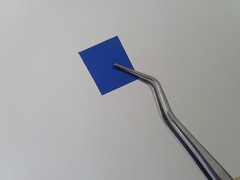
Near-Infrared Camera
Link to Kickstarter
We are able to tweak a single camera to capture near-infrared, green, and blue light. This allows us to photograph the secret life of plants. We do this by filtering out the red light, and reading infrared in its place using a piece of carefully chosen "superblue" filter.
Three models
DIY Filter Pack: This is just a piece of "superblue" filter which you can use to turn your webcam or cheap point-and-shoot into an infrared camera. The filter allows you to take an infrared photo in the "red" channel of your camera, and a visible image in the "blue" channel. You'll also receive a white balance card and instructions on how install your filter -- it's pretty easy!
Webcam: This cheap but flexible reward is perfect for plugging directly into your laptop or integrating into other projects. It's also ideal for your Raspberry Pi, if you want to take it outdoors, do timelapse photography, or write scripts to control your camera. It ships as a bare circuit board with a USB cable - like an Arduino.
Point & Shoot: This is the camera we designed for ourselves, a straightforward, if basic, point-and-shoot. You can simply take photos as you normally would, then upload them to our free and open-source web app to quickly and easily get a variety of composite images and analyses. To accomplish this, we're simply modifying existing cameras which we'll buy in bulk with the best specs we can reasonably get, using the "superblue" filter. This isn't an SLR or even a particularly fully featured camera -- it likely won't have an LCD screen and may be "rebranded" with a Public Lab sticker -- but it's the new filter we've put inside which counts. The final configuration will depend on the # of backers, but it will likely use AAA batteries and use a micro SD card. We're promising a minimum of 2 megapixel resolution, but should be able to do much better, especially if we get a lot of backers. Basically, the more money we raise, the better these cameras will get!
How you'll create your images:
Whether you're using our DIY filter with your own camera, the Webcam, or the Point & Shoot, you'll be following the same, easy process to generate composite, infrared + visible images that will reveal new details of plant health and photosynthesis.
1. Calibrate. In order to get the most meaningful data possible from your plant images, it's a good idea to "calibrate" your camera, taking into account the current lighting conditions (sunny vs. cloudy, indoors vs. outdoors) at the time that you're taking your photos: this makes it much easier to compare "plant health" images taken at different times, in different places, and by different cameras. To make this easy, we'll likely be providing an additional "white balance card" -- simply, a card that has a standard color -- in our kits. By recording an initial image that includes this card, you'll be able to use our online software to "standardize" the colors in all of your images. If you don't have a card, don't worry -- there will also be opportunities to calibrate your imagery automagically later, using our analysis software, and the results might be just as good.
2. Take your snapshot. "Rhododendrons -- say cheese!" Using your own camera (modded with our DIY filter), the Infragram Webcam, or the Infragram Point & Shoot, you'll record the scene of your choosing -- ideally, with some vegetation-y life forms in it. Take pictures of household plants, garden vegetables, trees -- we've grabbed a lot of useful agricultural imagery from cameras dangling from kites and balloons! The Public Lab website and mailing list are already full of examples and suggestions related to infrared photography, and it's easy to start a discussion with community members about your ideas, or ask for advice.
3. Upload. After you've finished an image capture session, you'll want to upload your images using the (free, open source) online software our community is developing. This will likely simply involve navigating to a particular URL and dragging-and-dropping your images onto a specified area of a webpage. Easy peasy.
4. Analyze. If you thought the prior steps were fun, this step is fun +1 . We're planning on providing a suite of image analysis tools online, so that everyone from researchers to geek gardeners can analyze, tweak, modify, and re-analyze their imagery to their heart's content, extracting useful information about plant health and biomass assessment along the way.
5. Share. And perhaps the most exciting aspect of all: your imagery, your work, and your insights can easily be shared with the rest of the Public Lab community via this online service, the Public Lab mailing lists, and wikis and research notes at http://publiclab.org. Develop a kite-based aerial imagery project with your friends; get advice from NDVI researchers in the community as to the best techniques for yielding useful information from your garden photos; create and collaborate on new methods and protocols around DIY infrared photography. Join Public Lab's "share and share alike", open source learning community: http://publiclab.org/wiki/registration
